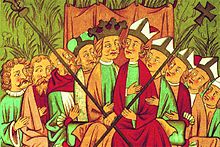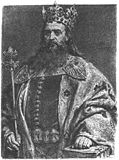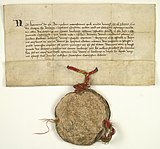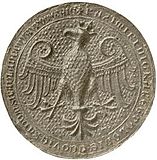Casimir III the Great
| Casimir III the Great | |
|---|---|
Piast | |
| Father | Władysław I Łokietek |
| Mother | Jadwiga of Kalisz |
| Signature |  |
Casimir III the Great (
Casimir inherited a kingdom weakened by war and made it prosperous and wealthy. He reformed the Polish army and doubled the size of the kingdom. He reformed the judicial system and introduced a legal code, gaining the title "the Polish Justinian".[1] Casimir built extensively and founded the Jagiellonian University (back then simply called the University of Krakow),[2] the oldest Polish university and one of the oldest in the world. He also confirmed privileges and protections previously granted to Jews and encouraged them to settle in Poland in great numbers.[3]
Casimir left no legitimate sons. When he died in 1370 from an injury received while hunting, his nephew, King Louis I of Hungary, succeeded him as king of Poland in personal union with Hungary.
The Great King

Casimir was born on 30 April 1310 in
Casimir began to rebuild the country and strengthen its defenses. During his reign, nearly 30 towns were supplied with fortification walls and some 50 castles were constructed, including castles along the Trail of the Eagle's Nests. These achievements are still celebrated today, in a commonly-known ditty that translates as follows: inherited wooden towns and left them fortified with stone and brick (Kazimierz Wielki zastał Polskę drewnianą, a zostawił murowaną).[6]
He organized a
Reforms
Casimir ensured stability and great prospects for the future of the country. He established the Corona Regni Poloniae – the Crown of the Polish Kingdom,[6] which certified the existence of the Polish lands independently from the monarch. Prior to that, the lands were only the property of the Piast dynasty.
At the
Politics and expansion
Casimir demonstrated competence in foreign diplomacy and managed to double the size of his kingdom. He neutralized relations with potential enemies to the west and north, and began to expand his territory eastward. He conquered the Ruthenian kingdom of Halych and Volodymyr (a territory in the modern-day Ukraine), known in Polish history as Red Ruthenia and Volhynia. By extending the borders far south-east, the Polish kingdom gained access to the lucrative Black Sea trade.[10]
Succession
In 1355, in Buda, Casimir designated his nephew Louis I of Hungary as his successor should he produce no male heir, just as his father had with Charles I of Hungary to gain help against Bohemia. In exchange Casimir gained a favourable Hungarian attitude, needed in disputes with the hostile Teutonic Order and the Kingdom of Bohemia. At the time Casimir was 45 years old, and so producing a son did not seem unreasonable.[11]
Casimir left no legal son, however, begetting five daughters instead. He tried to adopt his grandson,
Thus King Louis I of Hungary became successor in Poland. Louis was proclaimed king upon Casimir's death in 1370, though Casimir's sister Elisabeth (Louis's mother) held much of the real power until her death in 1380.[13]
Society under the reign of Casimir

Casimir was facetiously named "the Peasants' King". He introduced the codes of law of Greater and Lesser Poland as an attempt to end the overwhelming superiority of the nobility. During his reign all three major classes — the nobility, priesthood, and bourgeoisie — were more or less counterbalanced, allowing Casimir to strengthen his monarchic position. He was known for siding with the weak when the law did not protect them from nobles and clergymen. He reportedly even supported a peasant whose house had been demolished by his own mistress, after she had ordered it to be pulled down because it disturbed her enjoyment of the beautiful landscape.[citation needed]
His popularity with the peasants helped to rebuild the country, as part of the reconstruction program was funded by a land tax paid by the lower social class.[6]
Relationship with Jews

On 9 October 1334, Casimir confirmed the privileges granted to Jews in 1264 by
Relationships and children
Casimir III was married four times:
Aldona of Lithuania
On 30 April or 16 October 1325, Casimir married
- Bogislaus V of Pomerania[19]
- Cunigunde of Poland (1334–1357),Louis VI the Roman, the son of Louis IV, Holy Roman Emperor
- Anna[19]
Aldona died on 26 May 1339. Casimir remained a widower for two years.
Adelaide of Hesse
On 29 September 1341, Casimir married his second wife, Adelaide of Hesse. She was a daughter of Henry II, Landgrave of Hesse, and Elizabeth of Meissen. They had no children. Casimir started living separately from Adelaide soon after the marriage. Their loveless marriage lasted until 1356, when he declared himself divorced.[20]
Christina Rokiczana
After Casimir "divorced" Adelaide he married his mistress
Hedwig of Żagań
In about 1365, Casimir married his fourth wife
- Jogaila of Lithuania when he was king of Poland (as Władysław II Jagiełło). Anna married secondly Ulrich, Duke of Teck; they had no children.
- Kunigunde of Poland (1367 – 1370)
- Jadwiga of Poland (1368 – ca. 1382)
As Adelheid was still alive (and possibly Christina as well), the marriage to Hedwig was also considered bigamous. Because of this, the legitimacy of his three young daughters was disputed.[22] Casimir managed to have Anna and Kunigunde legitimated by Pope Urban V on 5 December 1369. Jadwiga the younger was legitimated by Pope Gregory XI on 11 October 1371 (after Casimir's death).[23]
Title and style
Casimir's full title was: Casimir by the grace of God king of
Popular culture
Film
- Casimir III the Great is one of the main characters in Polish historical drama series Korona królów (The Crown of the Kings). He is played by Mateusz Król (season 1) and Andrzej Hausner (season 2).[25]
- Casimir III the Great is mentioned in a speech by Amon Göth in the film Schindler's List.[26]
Video games
- Casimir features as a playable leader in the 2010 strategy game Civilization V, having been added in its 2013 expansion, Brave New World.
- Casimir also features as a ruler in the strategy game Crusader Kings II.
Currency
- Casimir is featured on the obverse of the 50 Polish złoty banknote, with his regalia on the reverse.[27]
Gallery
-
Casimir III the Great by Jan Matejko
-
Casimir the Great by Leopold Loeffler
-
Casimir III's tomb at Wawel Cathedral
-
Document issued by Casimir the Great granting the Armenian bishop Gregory (Գրիգոր) the right to stay and preach in Lviv, 1367
-
Royal seal, 1334
See also
- History of Poland (966–1385)
- Jagiellonian University
- Kazimierz Wielki University in Bydgoszcz
- Congress of Kraków
- Kazimierz
- Kazimierz Dolny
- List of Poles and Poulaines
- Esterka
Notes
References
- ^ a b Saxton, L. C. (1851). Fall of Poland; containing an analytical and a philosophical account of the causes which conspired in the ruin of that nation; together with a history of the country from its origin, in two volumes. Vol. I. New York: Charles Scribner publishing company. pp. 89.
- ^ Saxton, 1851, p. 535
- ISBN 978-0-8264-1886-9.
- ^ a b "Kazimierz III Wielki (1310–1370)". Retrieved 28 March 2020.
- ^ Lerski 1996, p. 249–250.
- ^ ISBN 978-0-87580-756-0.
- ISBN 9780754656449.
- ^ "Czy Kazimierz Wielki zasłużenie nosi przydomek "wielki"? Argumenty za". Retrieved 29 March 2020.
- ISBN 9781317467519.
- ISBN 978-0-87580-756-0.
- ^ "Władca, który zasłużył na swój przydomek. Dziś rocznica śmierci Kazimierza Wielkiego". Retrieved 28 March 2020.
- ^ "Kunegunda, córka Kazimierza Wielkiego: nieszczęśliwa panna młoda". Retrieved 29 March 2020.
- ISBN 9780521853323.
- ^ "In Poland, a Jewish Revival Thrives—Minus Jews". The New York Times. 12 July 2007.
- ^ "Esterka: między legendą a prawdą historyczną". Retrieved 28 March 2020.
- ^ Rowell 1994, p. 232.
- ^ Frost 2015, p. 28.
- ^ Rowell 1994, p. 91-92.
- ^ a b c Davies 1982, p. 65.
- ^ Rhode, Gotthold K.S. "Casimir III". Encyclopædia Britannica. Encyclopædia Britannica, inc. Retrieved April 12, 2018.
- ^ "Krystyna Rokiczana. Romans Kazimierza z piękną Czeszką zakończony bigamicznym małżeństwem". Retrieved 28 March 2020.
- ^ "Nieszczęśliwy małżonek. Kazimierz Wielki – bigamista do kwadratu". Retrieved 28 March 2020.
- ISBN 978-0-819-15463-7p. 119
- ^ Document Nr 1340 (CODEX DIPLOMATICUS MAIORIS POLONIA). POZNANIAE. SUMPTIBUS BIBLIOTHECAE KORNICENSIS. TYPIS J. I. KRASZEWSKI (Dr. W. ŁEBIŃSKI). 1879.
- ^ "PEŁNA OBSADA I TWÓRCY". Retrieved 29 March 2020.
- ^ "SCHINDLER'S LIST SCRIPT" (PDF). Retrieved 29 March 2020.
- ^ "Narodowy Bank Polski - Internet Information Service". www.nbp.pl. Retrieved 2022-09-17.
Source
- Davies, Norman (1982). God's Playground: A History of Poland. Vol. I: The Origins to 1795. Columbia University Press.
- Frost, Robert (2015). The Oxford History of Poland-Lithuania. Vol. I, The Making of the Polish-Lithuanian Union, 1385–1569. Oxford University Press.
- Lerski, Halina (1996). "Casimir III the Great". Historical Dictionary of Poland, 966-1945. ABC-CLIO Press. pp. 249–250. ISBN 0313034567. Retrieved 8 September 2012.
- Rowell, S.C. (1994). Lithuania Ascending: A Pagan Empire within East-Central Europe 1295-1345. Cambridge University Press.
External links
- Bain, Robert Nisbet (1911). . Encyclopædia Britannica. Vol. 5 (11th ed.). pp. 446–447.





